‘We know who we are.’ Ambitious Cuban art exhibition in Miami gets personal
It’s a familiar sight for Cubans and Cuban-Americans who were scrolling through Facebook on July 11, 2021. Candy colored posts and angry Bitmojis. Cries for peace, demands for accountability, locations for protests and plenty of Cuban flags.
“Tumbaron la Internet pero no las ganas de ser libreee.”
“¡No queremos otro Mariel, queremos otra Cuba!”
“Voy para el Versailles Restaurant #SOSCuba”
The artwork, screenshots of posts about last year’s anti-government protests in Cuba by artist Reynier Leyva Novo, fills an entire wall at a new exhibition of Cuban and Cuban diaspora art. But the show, titled “You Know Who You Are, Recent acquisitions of Cuban art from the Jorge M. Pérez Collection,” spans far beyond political unrest.
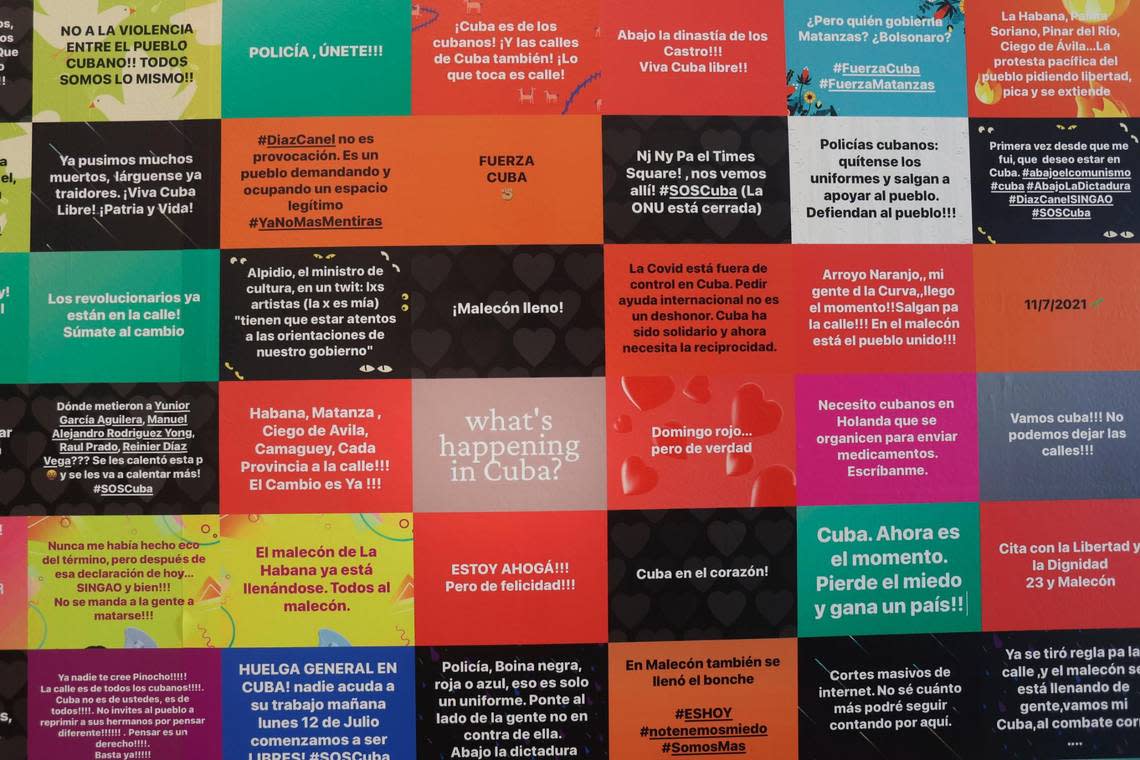
The exhibition opened late last month at El Espacio 23, a 28,000 square foot warehouse in Allapattah that was repurposed into a gallery and artist residency space by collector and philanthropist Jorge Pérez. The show consists of recently acquired works from his 5,000-piece collection. As the son of Cuban exiles, Pérez said he “felt it was my mission to bring awareness to the plight of the Cuban people.”
“However, as oppression and socio-political upheaval continues to impact the island and other countries around the world, we felt it was more important than ever to offer artists and the public a safe space where they could engage in a dialogue about the past, present and future of Cuba,” Pérez said in a statement. “I look forward to sharing these works, many of which have not been displayed publicly before, and sincerely hope they help show the world what’s at stake.”
The exhibition is sprawling, both physically and thematically. The two-story space is filled with 150 pieces by about 100 artists. Contemporary artists of Cuban heritage who were born on the island and abroad were included. Patricia M. Hanna and Anelys Alvarez, the exhibition’s co-curators, said the show touches on universal themes -- from propaganda to gender to nature -- that can resonate with anyone.
The show is divided into six sections: Heroes Do Not Weigh, Rights, There is Always a Larger Eagle Than You, Her in All Her Ways, Something That Binds Me, and All That is Solid Melts into Air.
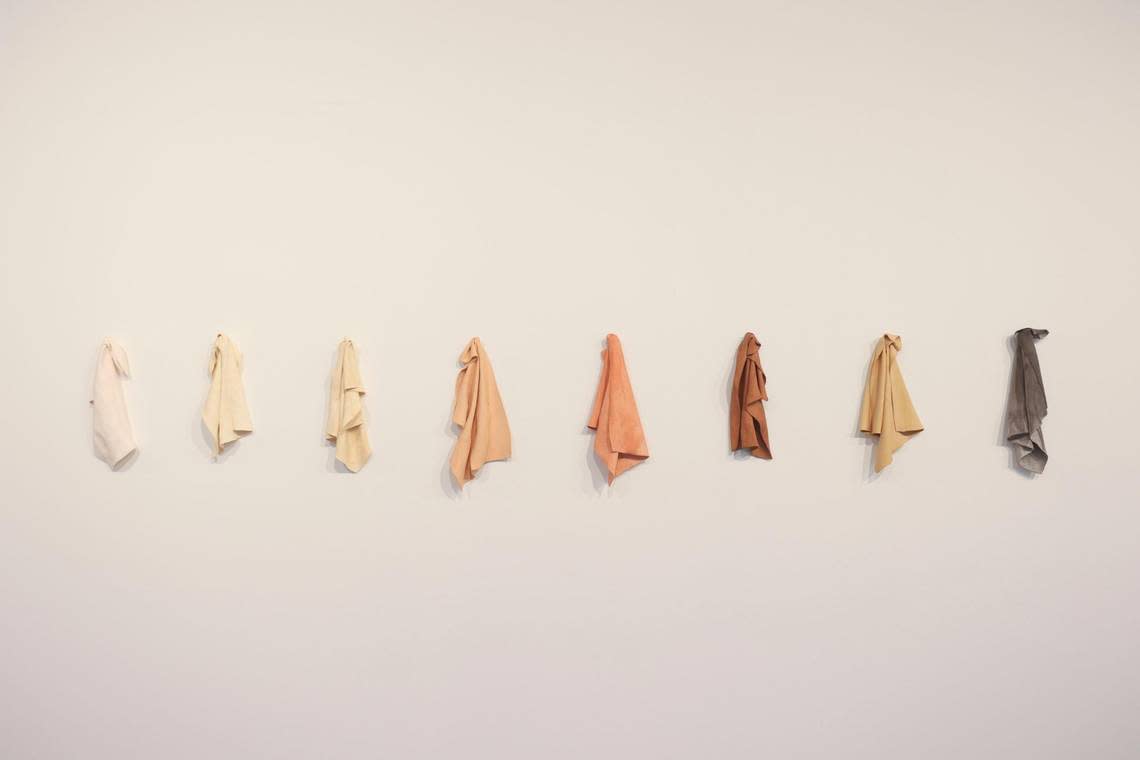
“We’ve been talking for so long about climate change, about human rights, about democracy,” Hanna said. “There’s so many topics that that are so relevant to today that we’re looking at through a Cuban lens.”
The exhibition is also timely, Alvarez said, as it brings to light the reality for artists living under an authoritarian regime. Since last year’s protests, many artists fled Cuba and its censorship.
Luis Manuel Otero Alcántara, an artist and activist who is featured in the show, is currently in prison in Cuba for protesting last year. His wooden sculptures of soldiers memorializes the thousands of Cubans who were injured and died after being sent to support a communist group during a conflict in Angola in the 1970s.
“We consider our space to be a place where artists have a voice.” Hanna said. “A lot of the of these artists have risked their own lives to express themselves, one of them is still sitting in jail, like Luis Manuel.”
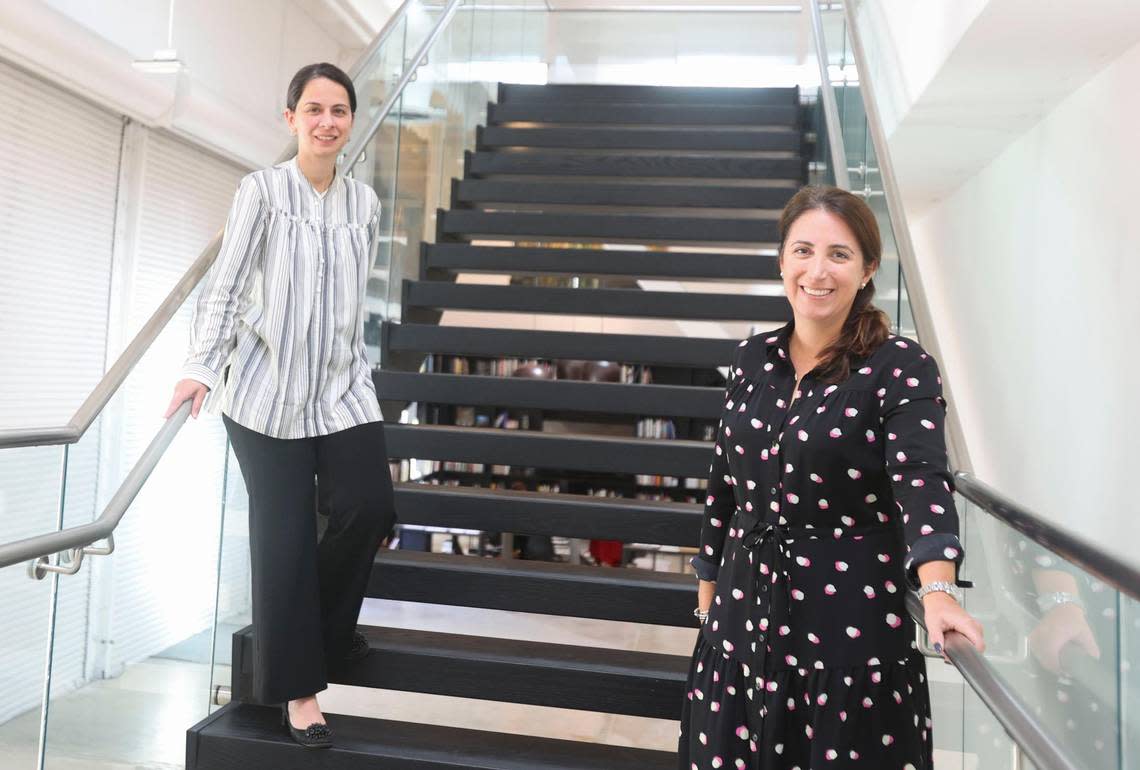
Circumventing censorship
The exhibition begins with broad themes like politics and historical heroes but becomes progressively more intimate and personal. The stories behind each piece of art are detailed and fascinating.
Several of the political works address serious topics with irreverence and a dark sense of humor -- like the toilet paper installed into the wall.
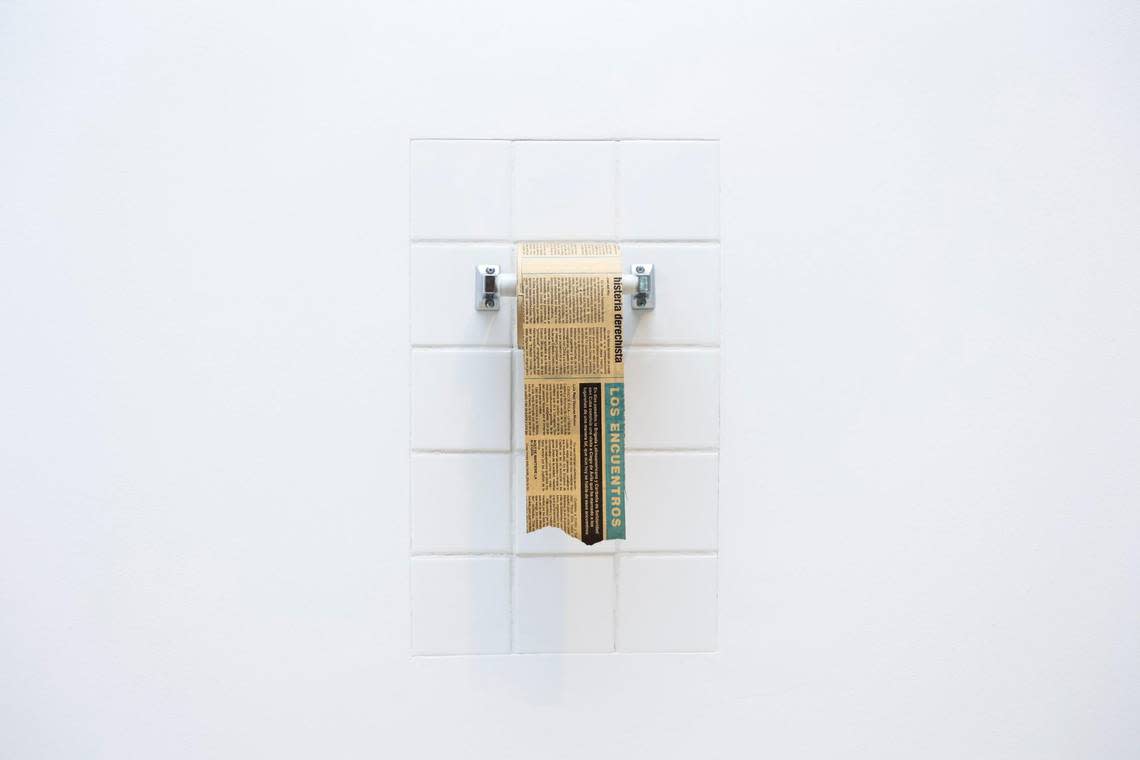
“Papel Periodico” by Wilfredo Prieto is just as it is described: a roll of toilet paper made from Cuban state-run newspaper, Granma. The artist lewdly criticizes the local, pro-government paper while simultaneously reflecting on the grim reality of shortages in Cuba. When there’s no toilet paper, people have had to use the newspaper instead. It’s a clever yet sad joke, Alvarez said.
Miami-based artist Antonia Wright’s “You Make Me Sick,” one of the few video pieces on display, comments on Castro’s impact and greed. The same day Fidel Castro stepped down from power in 2011, Wright filmed herself smoking a cigar nonstop while dressed in an olive green military outfit. She takes shallow breathes in between each puff, making herself physically ill from the smoke.
One of the more powerful pieces from the section examines the limits of propaganda. Leyva Novo’s “A Happy Day FC V” series is a group of famous images made almost unrecognizable. The artist edited Castro out of each photo.
“What is the power of the image when you edit out all the power?” Alvarez said.
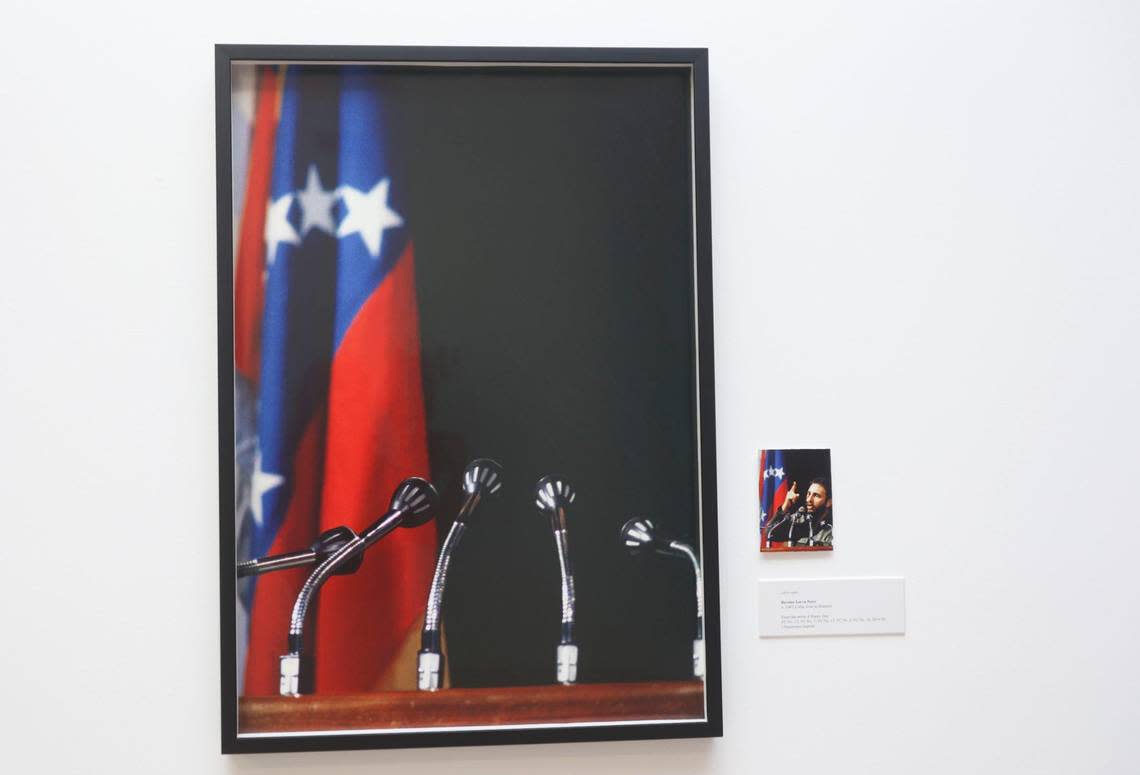
The show reflects an awkward dance between Cuba’s government and its artists. The government will support citizens with artistic talent to bring in revenue and international acclaim. But the artists balance on a thin tightrope, subtly critiquing the government while appeasing it.
A perfect example of this dance is “El bloqueo” by Tonel. It’s hard to miss. The artwork is large concrete block letters spelling “EL BLOQUEO” next to a model of Cuba made of cinder blocks. A version of the iconic piece was featured in Havana’s national museum, Alvarez said.
Many of the works have cheeky double-meanings, the curators explained. “El bloqueo” can be interpreted literally to place blame on the United States’ embargo as the source of Cuba’s problems. But the cinder blocks tell a different story: an isolated, strict country sinking under its own weight.
“This artist has to navigate the system somehow, and they are very clever in the way they choose their subjects or how they do it and how they circumvent censorship,” Alvarez said.
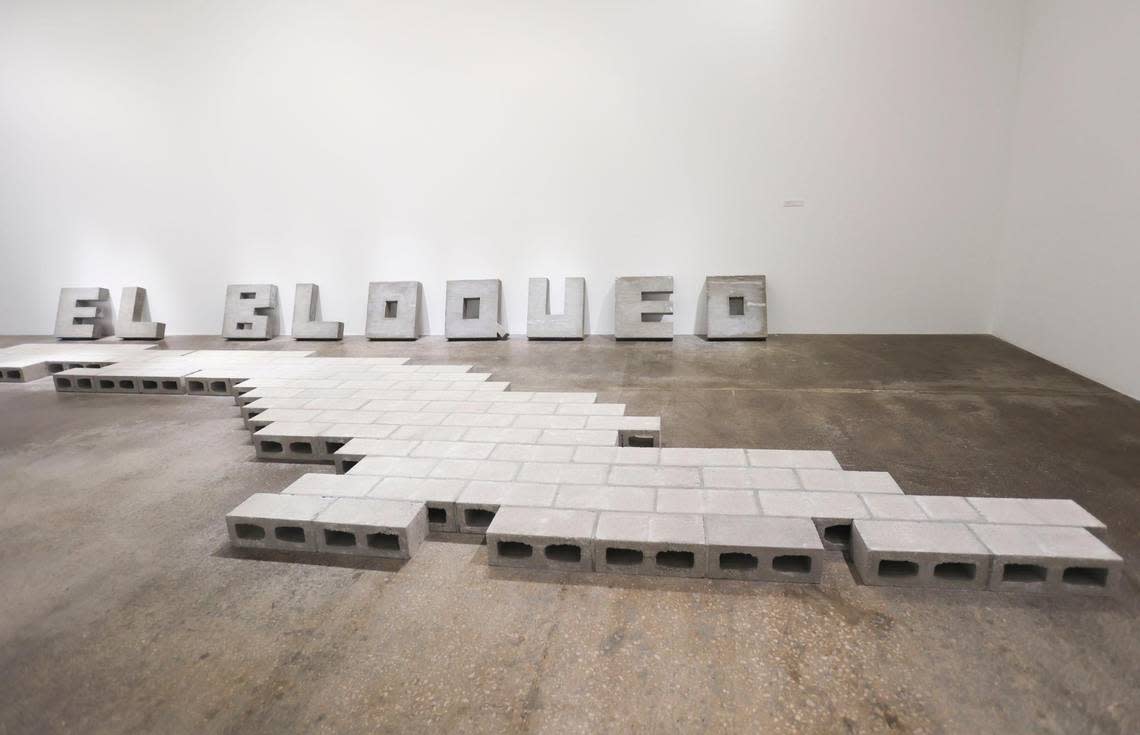
Tied to the past
The works become more introspective as the exhibition continues.
One room tells the wild story of Francisco de la Cal, a patriotic blind man riding a horse. Francisco, a fictional character by artist Fernando Rodriguez, holds a Cuban flag in one hand and his cane in the other as he rides his noble steed around the room. What he doesn’t know is that a rope tied to the horse is leaving a trail of his life story behind them, the curators explained. He doesn’t know it, but he is still tied to his past.
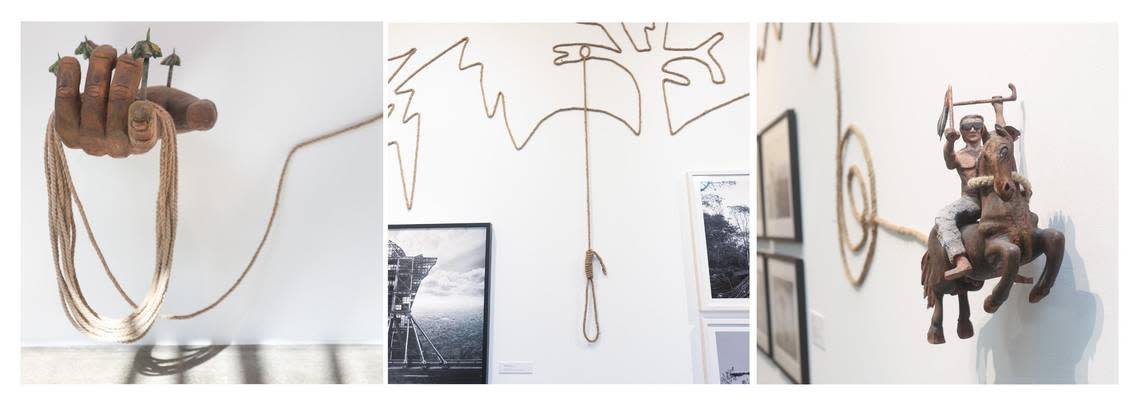
At the center of the room, a group of antique wooden cabinets tell another story about memories. Inside the shelves are hundreds of pieces of plant life from the Cuban countryside that artist Jose Eduardo Yaque preserved in bottles of aguardiente, water and honey.
Transporting the large, delicate piece from the artist’s studio in Cuba to Florida was a challenge, the curators recalled. Since the artwork contains liquids and agriculture from a foreign country, the antique furniture and glass bottles had to travel from Cuba to Italy to Miami. The effort was worth it.
“In a home, an armoire is where you keep your most sacred things, right? It’s where you keep your memories, where you keep heirlooms,” Hanna said. “In this case, he’s placing his land in here so it becomes this whole cabinet of memories.”
‘You know what you want’
In a divisive time where its difficult to have open communication, art makes those conversations possible. El Espacio 23’s exhibition aims to elevate those conversations on an international scale, Alvarez said.
The goal for art to strike a chord, Hanna added. In Miami, where Cuba’s legacy is felt everyday, that goal is within reach.
“The mission of all of our shows, I think, is to enjoy art for its beauty, but also for its content,” Hanna said. “We want people to think and we want people to reflect not only on their own personal histories, but where they are within their own context.”
The show’s namesake is a painting by Raúl Cordero, a Cuban-born artist who now lives in Mexico. At 16, while in art school in Cuba, he had stumbled upon a bunch of donated books in the library. The books were sorted into piles to be censored or approved. When nobody was looking, Cordero grabbed a random book from the top of the pile, shoved it into his backpack and ran home.
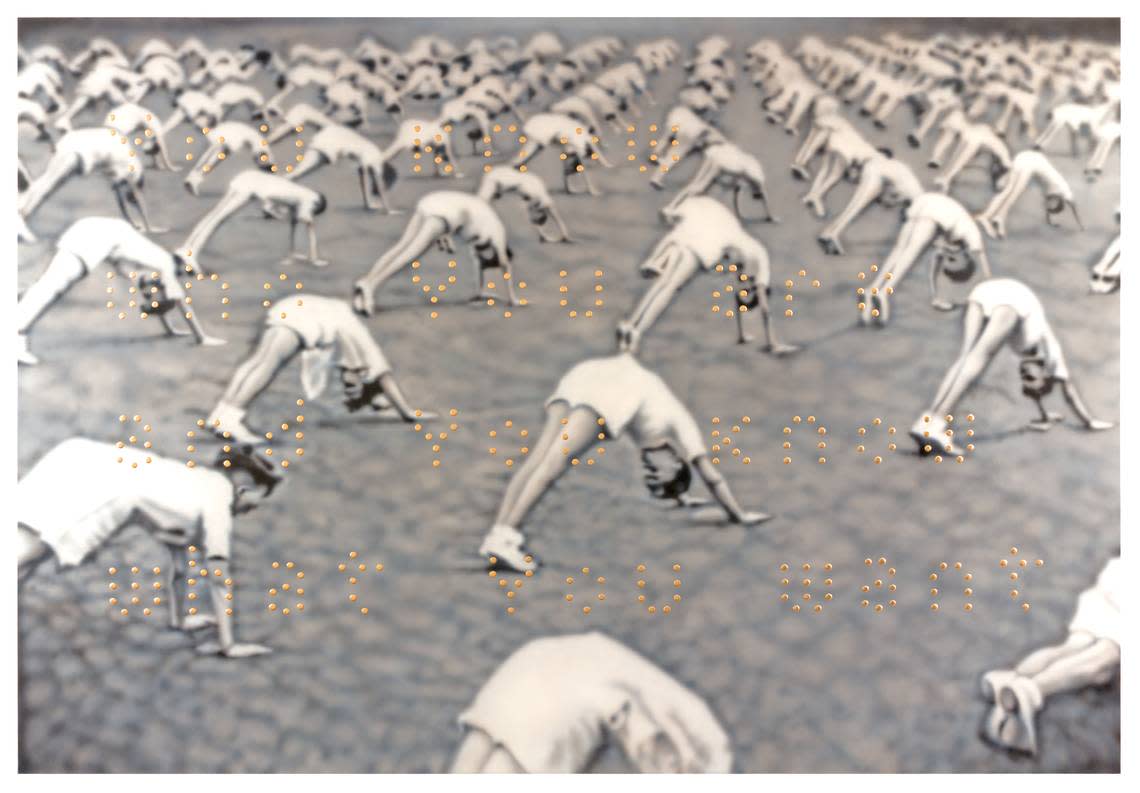
He stole a book about John Baldessari, an American conceptual artist whose artworks were unlike anything Cordero had ever seen before. He held onto the book for years, taking it with him every where he lived.
Years later, Cordero met Baldessari and told him the story. Cordero gifted him a book about his own artwork and told Baldessari that he was his greatest artistic influence. After looking at his book, Baldessari told Cordero something that has stuck with him every since: “Maybe you think that I’m your main artistic influence, but what I see here is that you know who you are and you know what you want.” After Baldessari died in 2020, Cordero made the painting in his memory.
Every artist featured in the show -- regardless of who they are or where they live -- has that in common, the curators said.
“All these artists know exactly who they are,” Hanna said. “And we know who we are as a collection. We know who we are as a space.”
You Know Who You Are, Recent acquisitions of Cuban art from the Jorge M. Pérez Collection
Where: El Espacio 23, 2270 NW 23rd St.
When: On view until June 2023
Hours: 10 a.m. to 5 p.m., Thursday to Saturday
Info: Free admission. Exhibition viewings by appointment only. elespacio23.org/visit/
This story was produced with financial support from The Pérez Family Foundation, in partnership with Journalism Funding Partners, as part of an independent journalism fellowship program. The Miami Herald maintains full editorial control of this work.
